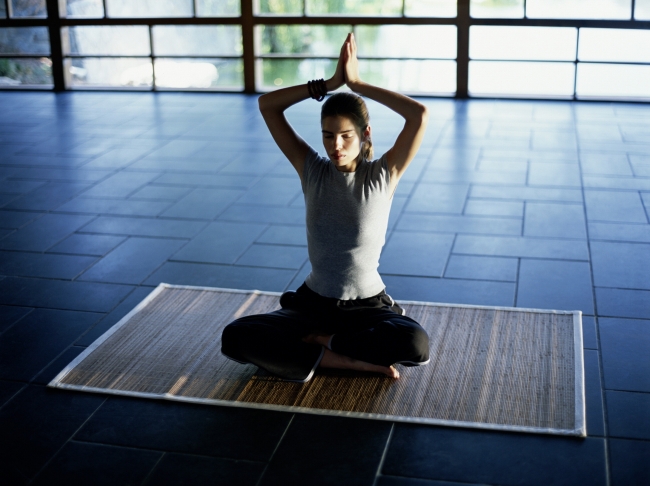
Sinus symptoms cause a substantial amount of discomfort in an individual causing difficulty in breathing. There are a number of yoga poses to deal with sinus symptoms. Yoga apart from being a natural healing process also helps you to live an overall healthier life. The following asanas will help soothe and relax the physical and emotional aspects of your life. If you know the exact postures and the right steps to perform them, then you can definitely get rid of sinusitis.
Sarvangasana (shoulder stand)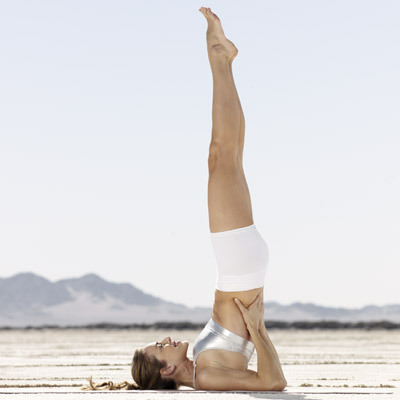
Sarvangasana is considered to be the mother of asanas. Regular practice of this asana eradicates common colds and other nasal disorders. You should practice this pose for at least 2 minutes.
Steps
1. Lie down on your back with your legs straight on the floor and palms facing downwards.
2. Inhale and slowly lift both your legs till it makes right angle with the rest of the body.
3. Lift your entire body by supporting your waist with both hands so that your elbow remains in contact with the floor. This position resembles a stand type arrangement. Your feet should remain in touch with each other and your eyes should be pointing towards the toes. Keep breathing.
4. This process makes your shoulders balance the entire body.
5. Reverse the same steps to get back to the normal position.
6. It is advised to practice shavasana for the same period to feel relaxed.
Benefits
This asana rejuvenates the entire body by strengthening the muscles of your lower back and stimulating the thyroid gland. It is also helpful for lungs and cures asthma.
Caution
People with stiff muscles and a weak lower back need to practice this pose carefully.
Simha asana (lion pose)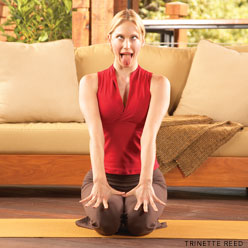
Simhasana in Sanskrit means the pose of a seated lion. In this royal sitting pose, the whole body including the facial expressions is modified to appeal to the legal force in the practitioner.
Steps
1. Sit in vajrasana pose with your back straight and hands placed on the thighs.
2. Slowly inhale and exhale keeping your mouth wide opened, tongue extending out and eyes pointing between the brows.
3. Remain in this position and spread and extend your fingers out over your knees.
4. Stay in this position and continue to inhale and exhale two to five times. You can feel the breath at the back of your throat.
5. Exhale as you come back to the original pose.
Benefits
It relieves sore throat and other respiratory disorders. Regular practice helps in better functioning of the carotid sinus and sinus nerves, and alleviating diseases of the nose, eyes and mouth.
Caution
If you are suffering from knee injury, you can try this pose by sitting on a chair.
Pavanmukta asana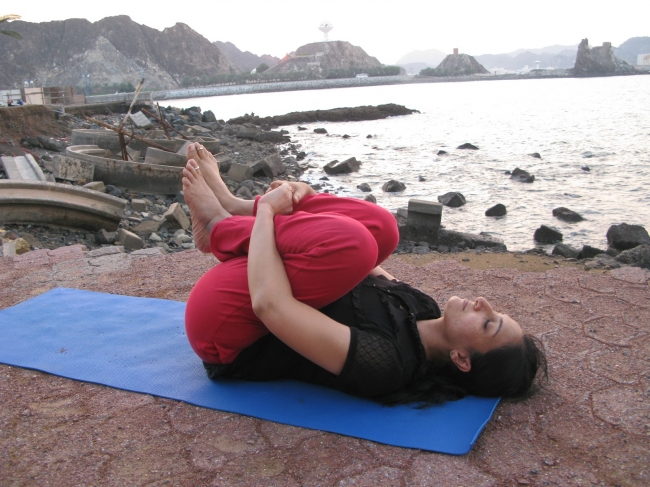
Pawan and muktha in Sanskrit means air or wind releasing. This asana helps in releasing unwanted gas from the stomach.
Steps
1. Lie down in shavasana pose.
2. Inhale and draw your knees towards your stomach as much as possible.
3. Exhale and force your knees to touch the chest with the help of your hands by interlocking the fingers beneath the knees.
4. Now raise your head and try to touch the nose with the knee. If you are not able to do this, you can try covering the distance as near as possible. Continue to breathe while remaining in this pose for 10-30 seconds.
5. You can repeat the steps for 3-5 times.
Benefits
It is the best exercise for people with gas problems, chronic ailments, sinus problems, acidity, heart problems and arthritis.
Caution
People suffering from severe back or waist pain should avoid this asana.
Matsya asana (the fish pose)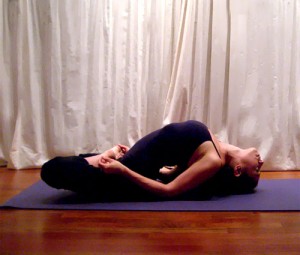
In this pose, the body takes up the shape of a fish in water where the thighs and knees are completely rested on the floor. As the back is curved, lot of weight is shifted to the head on the floor and the throat is stretched.
Steps
1. Lie down in supine position.
2. Move the legs one foot apart.
3. Fold the right leg and bring it over the left thigh.
4. Fold the left leg and bring it over the right thigh.
5. Taking the support of your elbows, raise the head; curve the back to form an arch while the top of your head is rested on the floor.
6. Grab the toes of your feet with hands and continue breathing.
7. Release the toes, bring back the legs to the normal position and return to supine pose.
8. This pose should be maintained for one tenth of the period of sarvangasana.
Benefits
This asana stretches the thyroid and pituitary glands thereby improving the blood circulation and assuring healthy functioning.
Caution
The weight over the head should be released slowly. Avoid jerks and speedy movements.
Surya namashkar (sun salutation)
This asana is a combination of 12 spinal positions. It improves flexibility and breathing. It should be practiced preferably in the morning and facing east.
Steps
1. Prayer pose
Stand erect with hands folded in a prayer position.
2. Raised arms pose
Inhale as you raise your arms over your head and bend backwards.
3. Head to foot pose
Exhale as you bend forward to touch the floor with your hands and keep your knees straight.
4. Equestrian pose
Bend the right knee and stretch back the left leg as far as possible so that your palms are resting on the floor. Hold your breath while the weight of the body is supported on your hands.
5. Mountain pose
Exhale as you straighten the left leg and place it beside the right one. Lift the buttocks and raise your head with the heels on the floor.
6. Ashtanga namaskara pose
Lower the body to the floor such that your toes, knees, hands, chest and chin touch the floor and the hips and abdomen should be raised. Hold your breath in this pose.
7. Bhujangasana pose
Inhale as you lift the body from your waist by straightening your arms. Arch your back to the maximum.
8. Mountain pose
Exhale and come back to the mountain pose.
9. Equestrian pose
Inhale and repeat the step four.
10. Head to foot pose
Perform the same step three
11. Raised arms pose
Repeat step two
12. Prayer pose
Come back to step one
Benefits
Strengthens the entire body, retards obesity and improves blood circulation. Alleviates from sinus and other respiratory disorders. Begin this asana with 3 times a day and gradually increase it to 12 times.
Setu bandha sarvanganasana (bridge pose)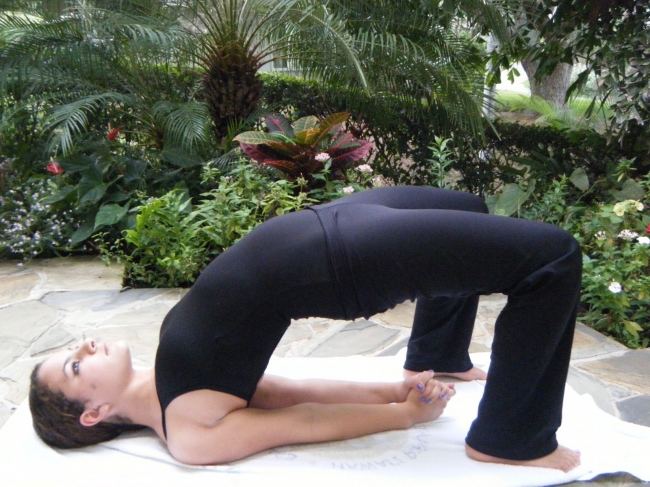
Setu bandha in Sanskrit means bridge locked. The practitioner resembles a bridge in his final posture.
Steps
1. Lie down in supine position.
2. Bend your knees with your feet resting on the mat.
3. Draw your feet closer to your buttocks.
4. Your feet and knees must be in one line.
5. With the support of your arms, raise the hips off the floor so that the thighs are parallel to the floor.
6. Raise your chin, lift your chest and press it towards the chin while resting on your shoulder blades.
7. Remain in this pose for 10-15 seconds.
8. Exhale and slowly roll up the spine and come back to the starting position.
Benefits
This pose relieves sinus headache, insomnia and fatigue. Bridge pose is helpful in rejuvenating tired legs.
Caution
People with neck injury, low back pain or knee pain should avoid this pose.
Eka pada savarganasana (plow pose with one leg up and one down)
This asana is a one leg shoulder stand.
Steps
1. Perform the steps of sarvangasana. Remain in this pose to begin.
2. Slowly inhale and as you exhale bring down the right leg as you do in halasana while keeping the left leg in the shoulder stand pose.
3. Stretch your right leg with no bends in the knee joint.
4. Follow the same rules to the left leg which is in shoulder stand pose.
5. Remain in this pose for sometime and repeat the same steps for the other leg.
Benefits
This yoga pose tones the abdomen, leg muscles and relieves sinus ailments.
Caution
Don’t over bend the knee joint to reach the final position.




